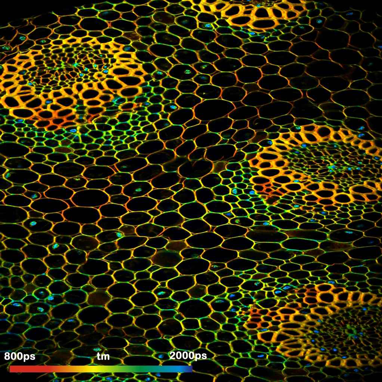The DCS‑120 MP is an extended version of the bh DCS‑120 confocal scanning FLIM System. It uses multiphoton excitation by a femtosecond titanium-sapphire laser, fast galvanometer scanning, non-descanned detection, hybrid detector technology, and single-photon recording by bh’s multi-dimensional TCSPC process. An AOM is included to control the laser power and to modulate the laser for PLIM acquisition. The system records FLIM data in two fully parallel recording channels, runs Z stacks, accumulates fast FLIM time series, and records simultaneously FLIM and PLIM. All components, including the laser and the AOM, are controlled by bh’s SPCM 64 bit data acquisition software. By using bh’s 64 bit Megapixel FLIM technology, images of the full field of view of the microscope can be recorded at diffraction-limited resolution. Image formats as large as 2048 x 2048 pixels with 256 time channels per pixel are available. The DCS-120 MP system is available with inverted microscopes of Zeiss, Nikon, and Olympus. Due to its fast scan rates and its high sensitivity, the DCS-120 MP is compatible with live cell and life tissue imaging. Typical applications are measurements of local molecular environment parameters, protein interaction experiments by FRET, imaging of metabolic parameters derived from the fluorescence decay functions of endogenous fluorophores, and correlated metabolic and oxygen saturation imaging. For more details please see application note ‘DCS-120 MP System Records Multiphoton FLIM and PLIM‘ and DCS-120 handbook.
Left: Convallaria sample with 1024 x 1024 pixels, 256 time channel per pixel. DCS-120 scan head, Nikon Eclipse inverted microscope, Spectra Physics Mai Tai laser. Microscope lens 20x NA = 0.5. Excitation wavelength 800 nm. Right: Phosphorescence Lifetime Image, recorded by bh’s PLIM technique based on laser modulation and dual-time-base recording.


